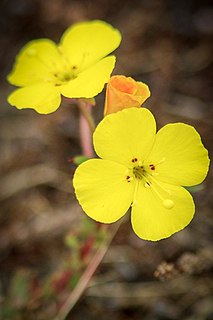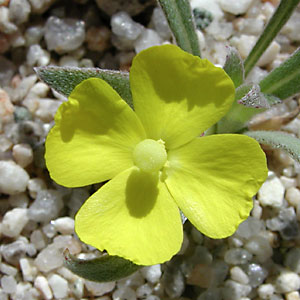
Camissoniopsis bistorta is a species of flowering plant in the evening primrose family known by the common names southern suncup and California suncup. It is native to southern California and Baja California, where it grows in several types of plant community along the coast and in the coastal hills and mountain ranges. This is a hairy annual or short-lived perennial herb spreading from a basal rosette, with stems reaching up to 80 centimeters long. The leaves are narrow and sometimes toothed, and 1 to 12 centimeters in length. Toward the end of the spreading stems are nodding inflorescences of flowers, each flower with four bright yellow petals dotted with red at their bases.

Chaenactis artemisiifolia, with the common name white pincushion, is a species of flowering plant in the daisy family. It is native to the coastal Peninsular Ranges of Southern California and Baja California, in the chaparral and woodlands.

Symphyotrichum greatae is a species of flowering plant in the family Asteraceae endemic to California and known by the common name Greata's aster.
Astragalus subvestitus is a species of milkvetch known by the common name Kern County milkvetch.
Chylismia heterochroma is a species of evening primrose known by the common name Shockley's evening primrose. It is native to the desert slopes and woodland of eastern California and Nevada. It is a hairy, glandular annual herb growing a spindly stem up to a meter tall. There is a thick basal rosette of leaves which are mostly oval in shape and several centimeters in length, and generally no leaves higher up the stem. The inflorescence produces several small flowers with four oval petals just a few millimeters long and lavender in color with yellow-tinted bases. The fruit is a club-shaped capsule roughly a centimeter long.

Camissoniopsis hirtella is a species of evening primrose known by the common name Santa Cruz Island suncup. It is native to California and Baja California, where it grows on the slopes of coastal and inland hills and mountains, especially in areas that have recently burned. It is an annual herb producing a hairy stem up to about half a meter in height. Most of the leaves are located in a basal rosette at ground level and are oval in shape and a few centimeters in length. The nodding inflorescence produces flowers with sepals coated in long, glandular hairs, and bright yellow petals under a centimeter long each. The petals sometimes have red dots at their bases. The fruit is a coiling capsule up to 2 centimeters long.
Camissonia lacustris is a flowering plant species commonly called grassland suncup. It is an evening primrose endemic to California, where it grows on the grasslands of the Sierra Nevada foothills. It is also known from an area in the Northern Coast Ranges in Lake County.

Camissoniopsis pallida is a low growing, yellow-flowered annual plant in the evening primrose family, Onagraceae. It is known by the common names pale primrose or pale yellow suncup. It is native to the desert and scrub habitat of the region where Arizona, California, and Nevada meet. It is a roughly hairy annual herb growing in a low patch on the ground, sometimes producing an erect stem from the basal rosette. The herbage is gray-green to reddish green. The leaves are lance-shaped and up to 3 centimeters long. The nodding inflorescence produces flowers with yellow petals 2 to 13 millimeters long, each with small red markings near the bases. The fruit is a straight to tightly coiled capsule.
Tetrapteron palmeri is a species of evening primrose known by the common name Palmer evening primrose. It is native to the western United States from California to Idaho, where it grows in several habitat types, including desert and sagebrush. It is a roughly hairy annual herb growing in a low patch on the ground, generally with no stem. The leaves are widely lance-shaped and up to about 5 centimeters long, with a few small teeth along the edges. The nodding inflorescence produces flowers with yellow petals only 2 or 3 millimeters long each and a noticeable bulbous stigma tip which may be up to a centimeter wide. The fruit is a leathery capsule around half a centimeter long with small wings near the tip.

Camissonia pubens is a species of evening primrose known by the common name hairy suncup. It is native to the desert and steppe of western Nevada and eastern California. It is an annual herb covered in glandular hairs generally made up of one or more erect, slender stems up to a third of a meter tall. The leaves are up to about 4 centimeters long and are lance-shaped with wavy, toothed edges. The nodding inflorescence produces flowers with yellow petals each a few millimeters long and sometimes dotted with red near the bases. The fruit is a straight or coiling capsule up to 5 centimeters long.
Camissonia pusilla is a species of evening primrose known by the common name little wiry suncup. It is native to the western United States from California to Idaho, where it grows in sagebrush and other habitat. It is a petite, hairy, glandular annual herb producing very slender erect stems up to about 22 centimeters in maximum height. The leaves linear with toothed edges and 1 to 3 centimeters long. The nodding inflorescence produces flowers with yellow petals 2 or 3 millimeters long and usually spotted with red near the bases. The fruit is a straight or coiling capsule up to 3 centimeters long.
Campanula californica is a species of flowering plant in the bellflower family Campanulaceae, known by the common names swamp bellflower and swamp harebell. It is endemic to California, where it grows along the coastline between Marin and Mendocino Counties. It is found mainly in wet areas such as bogs, marshes, and wet forest floors. This is a hairy rhizomatous perennial herb producing a thin, creeping stem 10 to 30 centimeters long. The thin, rippled leaves are oval in shape and between 1 and 2 centimeters long. The bell-shaped flower is pale blue with curving petals up to 1.5 centimeters long. The fruit is a ribbed, spherical capsule.

Caulanthus crassicaulis is a species of flowering plant in the family Brassicaceae known by the common name thickstem wild cabbage. It is native to the western United States where it is a member of the flora in sagebrush, woodland, and desert scrub habitats. This is a perennial herb producing a stout, inflated stem from a woody caudex base. The leaves form a basal rosette and occur at intervals along the stem. They are broadly lance-shaped on the lower stem and much smaller and linear in shape farther up. They may have smooth, toothed, or deeply cut edges. The rounded flower has a coat of thick, pouched sepals which part at the flower tip to reveal narrow dark purple or brown petals. There are two varieties of this species: var. crassicaulis generally has hairy flowers, while var. glaber has hairless. The fruit is a long, thin silique which may approach 13 centimeters in length.
Caulanthus glaucus is a species of flowering plant in the family Brassicaceae known by the common name glaucous wild cabbage.
Caulanthus hallii is a species of flowering plant in the family Brassicaceae known by the common name Hall's wild cabbage.
Chorizanthe uniaristata is a species of flowering plant in the buckwheat family known by the common name one-awn spineflower. It is endemic to central California, where it is known from several of the local mountain ranges, as well as the Central Coast.
Clarkia prostrata is a species of flowering plant in the evening primrose family known by the common name prostrate clarkia. It is endemic to the coastline of San Luis Obispo County, California, where it grows on seaside bluffs in forested and grassy areas. This annual herb is prostrate as opposed to erect as most other Clarkia species are. Its stems extend to a maximum length approaching half a meter and are usually somewhat fuzzy in texture. The leaves are oval in shape, up to 2.5 centimeters long, and lack petioles. The sepals of the flower separate into two pairs, revealing the lavender-pink blooming petals. Each petal is just over a centimeter long, fan-shaped to oval, and sometimes with a yellow base marked with a red spot.
Epilobium foliosum is a species of flowering plant in the evening primrose family known by the common names leafy willowherb and California willowherb. It is native to parts of western North America from British Columbia through California to Arizona, where it grows in many types of habitat, including disturbed areas.

Oenothera wolfii is a rare species of flowering plant in the evening primrose family known by the common name Wolf's evening primrose. It is native to the coastline of southern Oregon and northern California, where it grows in coastal prairie, dunes, and coastal forest and woodland habitat. As of 1997 it was known from only about 16 occurrences. The biggest threat to the plant is its easy hybridization with its relative and probable descendant, Oenothera glazioviana. As this rare wild plant crosses with the introduced garden escapee, introgression occurs, causing what is known as genetic pollution; fewer pure individuals of O. wolfii will be seen as they are outnumbered by hybrids.

Potentilla cristae is a rare species of cinquefoil known by the common name crested cinquefoil. It is endemic to the Klamath Mountains of far northern California, where it is known from a few occurrences in the subalpine and alpine climates of the high mountain ridges. It grows in talus and moist rocky or gravelly serpentine soils. This is a low, matted plant producing a clump of hairy, glandular herbage up to about 20 centimeters tall. Each hairy leaf is divided into three rounded leaflets which are toothed or lobed and measure up to 2 centimeters in length. The inflorescence is a cyme of a few flowers, each with five small yellow petals. The fruit is a minute achene just a millimeter wide, which is smooth with a crest.









